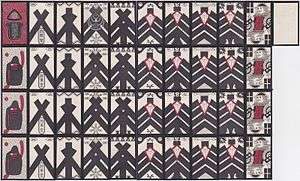Kabufuda

Kabufuda (株札) are Japanese playing cards used for gambling games such as Oicho-Kabu.
Kabufuda cards, like the related hanafuda ("flower cards") are smaller and stiffer than Western playing cards. A deck contains 40 cards, with designs representing the numbers 1 through 10. There are four cards for each number.
Like hanafuda, kabufuda is a descendent of mekuri karuta. Since suits don't matter in kabu games, all decks became single-suited during the 18th-century.[1] Like in baccarat, the object of most kabu games is to get a total closest to nine.[2] Early kabufuda decks had three ranks of face cards but since they have no value, only the jacks were kept. Kabu is believed to derive from the Portuguese slang cavo meaning a stake, bet, or wager.[3] Closely related are the gabo games played with Korean tujeon cards[4] and the Indian Ganjifa game of Komi.[5]
References
- ↑ Pollet, Andrea. Kabo patterns at Andy's Playing Cards. Retrieved 1 August 2015.
- ↑ Pakarnian, John, "Game Boy: Glossary of Japanese Gambling Games", Metropolis, January 22, 2010, p. 15.
- ↑ Fairbairn, John (1986). "A Card Game Played with Kurofuda". The Playing-Card. 15 (1): 27.
- ↑ Mann, Sylvia (1990). All Cards on the Table. Leinfelden: Deutsches Spielkarten-Museum. p. 335.
- ↑ Hopewell, Jeff (2006). "Komi and Nakash". The Playing-Card. 34 (1): 67.